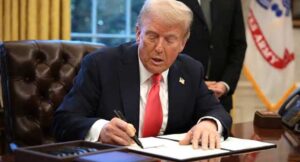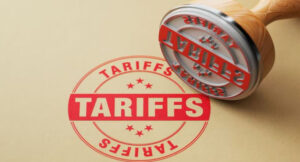Few domestic industries have been as devastated by the flood of cheap Chinese imports as manufacturers of face masks, exam gloves and other disposable medical gear that protects health care workers from infectious pathogens.
The industry’s demise had calamitous consequences during the Covid pandemic, when Beijing halted exports and American hospital workers found themselves at the mercy of a deadly airborne virus that quickly filled the nation’s emergency rooms and morgues.
But as President Trump unveiled his tariff regimen earlier this month, and Beijing retaliated with an 84 percent tax on American imports, the few remaining companies that make protective gear in the United States felt mostly unease.
“I’m pretty freaked out,” said Lloyd Armbrust, the chief executive of Armbrust American, a pandemic-era startup that produces N95 respirator masks at a factory in Texas. “On one hand, this is the kind of medicine we need if we really are going to become independent of China. On the other hand, this is not responsible industrial policy.”
The United States once dominated the field of personal protective equipment, or P.P.E. The virus-filtering N95 mask and the disposable nitrile glove are American inventions, but China now produces more than 90 percent of the medical gear worn by American health care workers.
Despite bipartisan vows to end the nation’s dependency on foreign medical products — and to shore up the dozens of domestic manufacturers that sprang up during the pandemic — federal agencies have resumed their reliance on inexpensive Chinese imports. Industry experts say the country’s renewed dependence on imported medical products is especially concerning given an expanding measles outbreak, the threat of avian flu and a trade war with China that some worry could affect global supply chains.
“It’s the same movie again and again,” said Mike Bowen, whose company, Prestige Ameritech, was one of the few domestic mask makers before the pandemic, and who repeatedly warned Congress about the risks of relying on foreign-made P.P.E.
Mr. Bowen, who retired four years ago but maintains a stake in Prestige Ameritech, said the rise and fall of the American P.P.E. sector over the past few years was entirely predictable. “We didn’t learn a thing,” he said.
Shocked by the images of nurses donning trash bags, John Bielamowicz, a commercial real estate broker in Texas, opened a N95 factory near Fort Worth with a friend, spending hundreds of thousands of dollars on machinery that would eventually churn out 1.2 million masks a month.
“It just seemed like the right thing to do,” said Mr. Bielamowicz, whose company, United States Mask, was one of more than 100 start-ups that sprung up during the first terrifying year of the pandemic.
Five years later, United States Mask and most of the other start-ups are gone. The companies were hit hard by slowing demand for P.P.E. as the pandemic retreated and as masks became a symbol of government overreach and loss of freedom for many Americans. But the death blow was seemingly preordained: the return of Chinese-made gear.
Only five of the 107 companies created during the pandemic are still making masks and gloves, according to a review of the membership list created by the American Medical Manufacturers Association.
Eric Axel, the association’s executive director, said the tariffs on Chinese-made protective gear, if they remained high, would give American producers a leg up. “I think it will change behavior, because people will have to adjust to the reality that you can’t buy below-market price rate stuff from China anymore,” he said.
But other industry executives worry the escalating retaliatory moves by the United States and China could lead to supply chain disruptions and a return of P.P.E. shortages. Many say the economic uncertainty prompted by Mr. Trump’s tariff rollout will chill new investment.
“It’s difficult to make business decisions when policies change every four years, and now every couple of days,” said Scott McGurl, a health care industry expert at the consultancy firm Grant Thornton.
Given the ability of Chinese manufacturers, with support from their own government, to circumvent trade restrictions, many executives are unconvinced the tariffs will have a lasting impact. What’s needed, they say, are legislative and policy mandates that push government agencies and hospital networks to buy American-made masks and gloves.
“Even with a 100 percent tariff, the Chinese mask that sells for a penny is still going to be cheaper than the American-made one that sells for eight cents,” Mr. Armbrust said.
The silver-lining story about how altruistic entrepreneurialism rallied to meet a grave public health emergency wasn’t supposed to end this way.
Political leaders from both sides of the aisle had vowed to never again to allow the nation to become reliant on foreign-made medical gear, and the Defense Department spent $1.3 billion helping American companies make N95 respirator masks and nitrile exam gloves in the United States.
In 2021, Congress drafted legislation to ensure that federal agencies prioritized the purchase of domestically made medical equipment to sustain the sector through the inevitable peaks and troughs of demand.
It is a model long embraced by the Pentagon, which spends hundreds of billions of dollars each year on contracts that sustain defense-related companies during times of war and peace.
But the P.P.E. measure, folded into the Infrastructure Investment and Jobs Act of 2021, contained loopholes that experts say rendered it ineffective as federal agencies sought waivers to buy less expensive imports.
When Mr. Axel of the medical manufacturer’s association recently traveled through John F. Kennedy International Airport in New York, he was flabbergasted to discover that the masks used at a federal health screening station were made in China.
“Our national security is at risk because we’ve once again put ourselves at the mercy of adversarial, nondemocratic countries,” he said.
Mr. Trump has not mentioned personal protective equipment since returning to office, but during his first term he often spoke about the need to wean the country off foreign-made medical gear as part of his “America first” economic policy.
“Never again will another president inherit empty shelves,” he said in May 2020, speaking at a Pennsylvania mask facility operated by Owens & Minor. “My goal is to produce everything America needs for ourselves and then export to the world.”
Experts say the tariffs that Mr. Trump imposed on Chinese goods during his first term did little to level the playing field, mostly because Beijing’s generous industrial policy helped Chinese companies maintain their price advantage.
The Trump administration did not respond to requests for comment.
For now, the vast majority of masks purchased by hospital chains, federal agencies and state governments are imported, mostly from China, and to a lesser extent, from Thailand, Vietnam and Mexico — countries that often repackage Chinese-made products to avoid the tariffs that were imposed on Beijing by the last two administrations.
Owens & Minor, the health care logistics company that Mr. Trump singled out for praise during the pandemic, sells masks that are assembled in Mexico. The company declined to discuss its production.
There are a few exceptions to the narrative. SafeSource Direct, one of the few companies that makes nitrile exam gloves in the United States, has been surviving, largely because of a partnership with the hospital network Ochsner Health, which buys a steady stream of them, according to Justin Hollingsworth, the chief executive of SafeSource Direct. Ochsner said its investment in SafeSource was intended to ensure its hospitals and clinics have a reliable source of medical supplies.
Armbrust American, the other pandemic-era startup still in business, gets by on purchases from travelers who don’t trust Chinese-made masks, and on bulk purchases by the retailer Target. Mr. Armbrust said Target executives were willing to pay 50 percent more for his masks and gloves because they saw the value in having a high-quality product made on U.S. soil.
Like most Americans, Dan Izhaky, a former wholesale distribution executive in New York, wasn’t familiar with the acronym P.P.E. when friends of his began complaining about waning supplies of masks and exam gloves at hospitals where they worked.
Six months later, United Safety Technology, the company he created to make P.P.E., won a $96 million federal contract to build a nitrile glove factory outside Baltimore.
The company moved quickly to outfit a massive 700,000-square-foot warehouse with machinery to produce 200 million gloves a month, but as pandemic-related supply chain issues led to spiraling costs for steel beams, computer chips and shipping containers, the company needed an additional $50 million to finish the project.
Federal officials were unmoved, he said.
“One or two long-term government purchase contracts would have gotten us over the finish line, but the team at H.H.S. just wasn’t interested anymore,” he said, referring to the Department of Health and Human Services.
And by the time federal officials pulled the plug, Chinese-made nitrile gloves were becoming plentiful again — and charging 1.3 cents a glove, about half what the company was planning to charge.
Still, Mr. Izhaky said he was cautiously optimistic Mr. Trump’s tariffs. “Things are going on the right trajectory,” he said on Friday. “I just wish they were a little bit less chaotic.”
Andrew Jacobs is a Times reporter focused on how healthcare policy, politics and corporate interests affect people’s lives. NY Times









